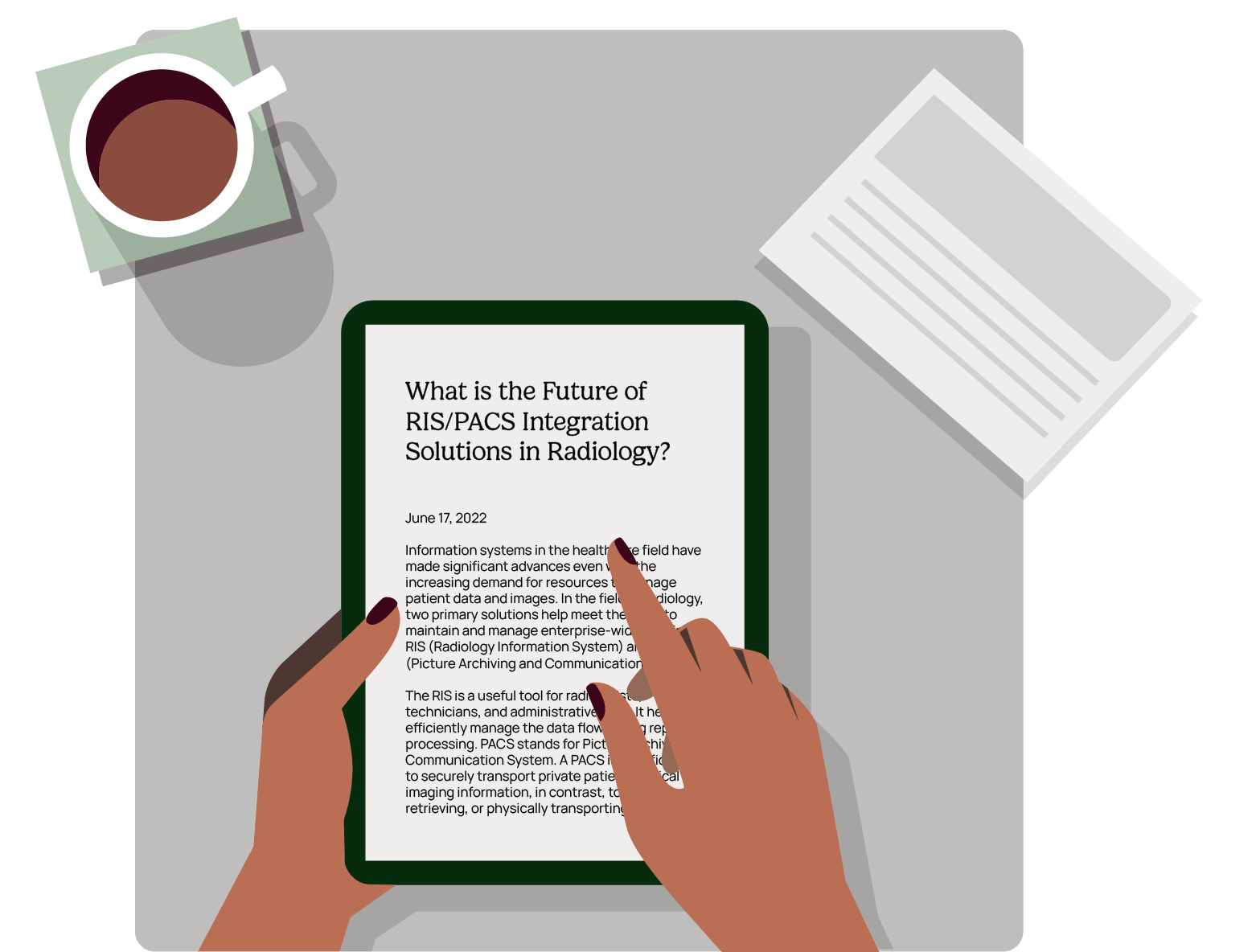Information systems in the healthcare field have made significant advances even with the increasing demand for resources to manage patient data and images. In the field of radiology, two primary solutions help meet the need to maintain and manage enterprise-wide imaging: RIS (Radiology Information System) and PACS (Picture Archiving and Communication System).
The RIS is a useful tool for radiologists, technicians, and administrative staff. It helps efficiently manage the data flow during reporting processing. PACS stands for Picture Archiving and Communication System. A PACS is an efficient way to securely transport private patient medical imaging information, in contrast, to manually filing, retrieving, or physically transporting film jackets.
The RIS/PACS integration in the medical setting has proven to be beneficial for both healthcare professionals and patients. We will evaluate the current landscape as well as the future of integrating the two solutions.
RIS (Radiology Information System)
Radiology Information Systems are powerful tools that help radiology professionals keep track of patient data and the immense image files typically generated during diagnosis or treatment. A RIS is an electronic health record (EHR) designed specifically for use in radiology, allowing practitioners to manipulate data and distribute images with ease.
The primary functions of a traditional RIS include scheduling, workflow, and managing procedures. Additionally, a RIS can handle patient registration and scheduling, patient management, patient tracking, image tracking, reporting, and billing.
Patient Registration and Scheduling
A RIS enables clinicians to save by enabling them to easily access vital patient information. The RIS allows clinicians to collect a wealth of patient information for registration and scheduling tasks. This allows caregivers to access a patient’s medical history and track treatment statuses, reducing the length of time a patient spends in the registration process. Furthermore, RIS systems can alert staff if a patient has been waiting too long for treatment. It can also help reduce claims denials due to incorrectly entered information.
Patient Management
When RIS is integrated with PACS, the system can seamlessly exchange images, documents, and information between the various databases. Furthermore, medical images can be accessed by healthcare professionals.
Patient Tracking
The RIS system makes it easier for providers to keep track of a patient’s history from admission until discharge. This allows caregivers to coordinate with past appointments or future ones, giving a more personalized experience that ensures accurate treatment planning.
Image Tracking
RIS/PACS systems allow for tracking associated medical images with related patient data. It can be used in conjunction with PACS (or VNAs) for image archive storage and retrieval. In addition to being an excellent way of tracking imaging orders, a RIS is also helpful for keeping track of billing information.
Reporting
A RIS can generate reports for specific procedures, individual patients, or a group of patients.
Billing
RIS systems can store detailed financial records, process electronic payments, and automate billing and claims.
PACS (Picture Archiving and Communication System)
PACS stands for Picture Archiving and Communication System. A PACS is an efficient way to securely manage private patient medical imaging information, in contrast, to manually filing, retrieving, or physically transporting film jackets. With PACS, medical professionals can store and digitally transmit images and clinical reports for immediate use at their discretion – a significant improvement over older, film-based systems. In addition, medical documents and images can be housed locally or offsite on secure servers and accessed using PACS software, workstations, or mobile devices.
RIS/PACS Integration
How important is it to integrate RIS with PACS? In radiology departments, the integration of the systems of patient images and patient information enables increased productivity, efficiency, and cost-effectiveness. Integrating RIS and PACS directly improves patient care by automating radiology workflows.
Benefits
Integrating RIS with PACS can help a diagnostician gain richer patient information, including past data and current patient information. The elimination of paper-based records reduces the length of stay for each patient while reducing potential legal liabilities that may come from lost files or films. More importantly, integrating PACS and RIS reduces or eliminates repetitive data entry, decreases the likelihood of human error, and provides more bandwidth for accurate data for automating the PACS, improving patient outcomes.
The Future of RIS/PACS Integration
We have pointed out several benefits of RIS and PACS and how the integration of the two systems helps save time and money while helping healthcare professionals become more efficient, and improving patient care. The future of combining such systems will inevitably lead to the integration of “the cloud” and artificial intelligence.
Cloud PACS are impactful to an organization because they can reduce IT workload, allowing internal IT resources to focus on more strategic initiatives by transferring the PACS management to the cloud providers. Furthermore, medical information is stored in a central database system which will not become subject to being “siloed.”
With artificial intelligence (AI) on the rise in adoption and usage in the field of radiology, it is important to be aware of how the technology will move the industry forward. AI in radiology saves time and resources, reduces workload and repetitive tasks, helps identify anomalies, and can help radiologists make better data-informed decisions.
In Summary
RIS and PACS are both essential for the modern healthcare facility. RIS provides a way to store, manage, and retrieve patient data. PACS allows for the storage and retrieval of images as well as other associated healthcare information. When these two systems are integrated, they provide a more complete view of the patient’s medical history. This can lead to quicker diagnoses, shorter lengths of stay, less repetitive data entry, and improved overall medical efficiency. If you would like to learn more about how our team can help you integrate RIS and PACS in your facility, please contact us today for a demo.




